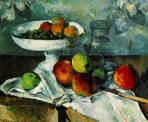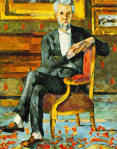|
Abstract Art - By Professor Dr. Saadat Saeed |
||
 |
|
|
The term abstraction is always used to describe non- personified feelings and objects. Abstract art embodies intrinsic shapes and captures non-pictorial elements of an object or picture.
In one of his articles on the issues of modern art entitled 'The liberating quality of Avant- Garde art' (published in Art news America in 1957) Meyer Schapiro writes
"In the course of last fifty years the painters who freed themselves from the necessity of representation discovered new fields of form-construction and expression including new possibilities of imaginative representation) which entailed a new attitude to art itself. The artist came to believe that what was essential in art — given the diversity of themes or motifs — were two universal requirements: that every work of art has an individual order or coherence, a quality of unity and necessity in its structure regardless of the kind of forms used and second that the forms and colors chosen have a decided expressive physiognomy, that they speak to us as a feeling-charged whole, through the intrinsic power of colors and lines, rather than through the imagining of facial expressions, gestures and bodily movement, although these are not necessarily excluded — for they too are forms."
Precisely, abstract art is an expression applied to relate basically non-illustrative or
non-substantial forms of depiction. Art critics include in it all the new forms discovered or invented in the twentieth century which communicate their meanings through suggestions, hints, clues, shades and allusions. It is said about abstract art that even though it ordinarily is applied to the most of the modern movements e.g. Surrealism, Symbolism, Dadaism, Fauvism, Expressionism, Cubism. It may also be applied to such old forms as Egyptian paintings, Romanesque paintings, Byzantine paintings and mosaics and other kinds to the extent that these also reduce the basic entity to a series of non-photographic frames, lines or colors. Through depictions of uncertain rather than categorical sketches. An abstract artist can encompass varieties and depths of his ideas and subjects. His fruition and real achievements are rooted in making his paintings, sculptures and designs more or less speculative and unnatural even to the extent that it lacks identity. In the modern period we find its elementary traces in Honore Daumier's Don Quixote, Paul Signac's Circus, and Vincent Van Gogh's Cypresses. Wassily Kanddinsky, Jackson Pollock, Willem De Kooning, Mark Rothko and Piet Mondrian have used skilfully the abstract forms discovered by them or few others among their contemporaries. Other modern painters who were fond of using fully or partly this method of painting were Henri Matisse, Pablo Picasso, Giorgio De Chirico, Georges Braque, Marcel Duchamp, Unberto Boccioni, Gino Severini, Giacomo Balla, Emil Nolde, Joan Miro, Franz Marc, Max Ernst, Juan Gris, Salvador Dali, Edvard Munch, Paul Klee, Marc Chagall.
In Pakistan Shakir Ali, Sadiqaine and Hanif Ramay introduced this technique and later many painters from A'zar Zobi to Aslam Kamal tried to adopt it truly or as a fashion. Anwar Jalal Shamza, Raheel Akber Javeed, Ahmad Pervez, Ejazul Hasan, Zubeda Siddiq, Sughra Rubabi, Abrar Termzi and Murshad adopted it to express their social, intuitive, aesthetic, expressionistic, impressionistic and surrealistic experiences. The developments in modern knowledge specially in the fields of science, philosophy, psychology, sociology, drawing and designing forced artists to create illusions of realities as it was not possible for them to paint corporeal, deep and hermetic realities in concrete forms.

